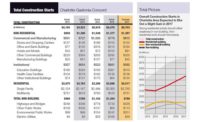Despite the marshy floodplain setting, the ever-present subsurface issue of inconsistently sloped bedrock necessitated the use of end-bearing piles drilled 60 to 80 ft deep.
With the Blue Line Extension's civil phase moving toward its scheduled spring 2016 completion, Balfour Beatty Infrastructure will soon begin installing the light rail track; overhead catenary and traction power systems; and train control, signal and communications systems throughout the route. Balfour Beatty also installed the foundations for the extension's 11 stations, which will include 15- to 18-ft-wide side- and center-loaded configurations with 276-ft-long platforms to be constructed along with other elements by station finishes contractor Edison Foard Inc., Charlotte.
In addition, Balfour Beatty is lengthening platforms at three stations along the original segment to 276 ft in order to accommodate three-car trains throughout the entire route.
"Our ridership volume opened higher than expected and will increase quickly once BLE opens because of more destinations," Rogers explains. CATS expects daily ridership to increase from its projected 2018 total of 18,000 passengers to 24,500 by 2035. A one-way trip along the nearly 19-mile line should take about 47 minutes.
Work has also begun on the Blue Line Extension's other vertical elements, including three multilevel precast parking garages with more than 3,300 spaces. A 20,300-sq-ft operations, service and inspection facility is set to get underway later this year.
Gregory Sigmon, project manager for STV, which designed the Blue Line Extension and is managing construction of the garages and maintenance facility for CATS, says the most challenging aspect involved with the design and construction of light rail transit systems is the many complex, interrelated project components. It's a lesson that other cities and contractors exploring light rail lines should be mindful of, he says.
"In a highway project, a signal system may be the most complicated feature," he says. "For light rail, you have numerous systems, alignments, at-grade crossings, revenue collection factors and many other things that have to be managed and coordinated. It's like putting a big puzzle together."







